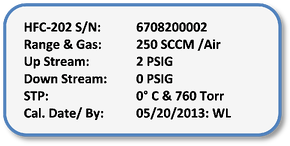We often see the label “One Size Fits All”. This may be fine for some consumer goods. However, it can be quite problematic when applied to items like shirts, gloves, or even golf clubs. “One Size Fits All” also does not work for Mass Flow Controllers (MFC). Not all applications are alike. Forcing a “One Size Fits All” MFC into an unsuitable application can squander accuracy and induce valve failure.
Why do you need to specify the gas flow range on a MFC? The Full Scale (FS) Range and Gas on a MFC directly correlates to the transmitted output (analog or digital) of the device. In an analog device, the maximum output value (such as 5 vdc or 20 mA) will be equivalent to the FS value. The accuracy of most MFCs is a function of this FS Range. For analog devices, it is commonly ±1% of FS. For digital devices, it is commonly published to be ±(0.5% of Reading + 0.2% FS). Selecting the FS Range close to an application’s maximum flow rate optimizes accuracy for that specific application. This is a good practice. In addition, the gas must be specified. Most MFCs use thermal based sensors. These sensors actually measure the molecular flow rate rather than the mass flow rate. Various gas molecules transfer heat differently, and thus the gas must be known.
Why do you need to specify Upstream Pressure and Downstream Pressure on a MFC? Again, not all applications are the same. A “One Size Fits All” MFC is typically not set up for applications at high pressure, low pressure, high differential pressure, or low differential pressure. The definition of high and low will also fluctuate from one user to another. Teledyne Hastings Instruments selects and tests MFC valve components (orifice, spring, etc.) that optimize valve stability for the exact application pressure conditions.When using a Teledyne Hastings Instruments MFC, you will always find the FS Range / Gas and the Upstream / Downstream Pressures listed on the serial number label.

Wayne Lewey was first exposed to mass flow controllers while an undergraduate at North Carolina State University (Chemical Engineering). Today, Wayne is the International Sales Manager at Teledyne Hastings Instruments and can be reached at wlewey@teledyne.com.
